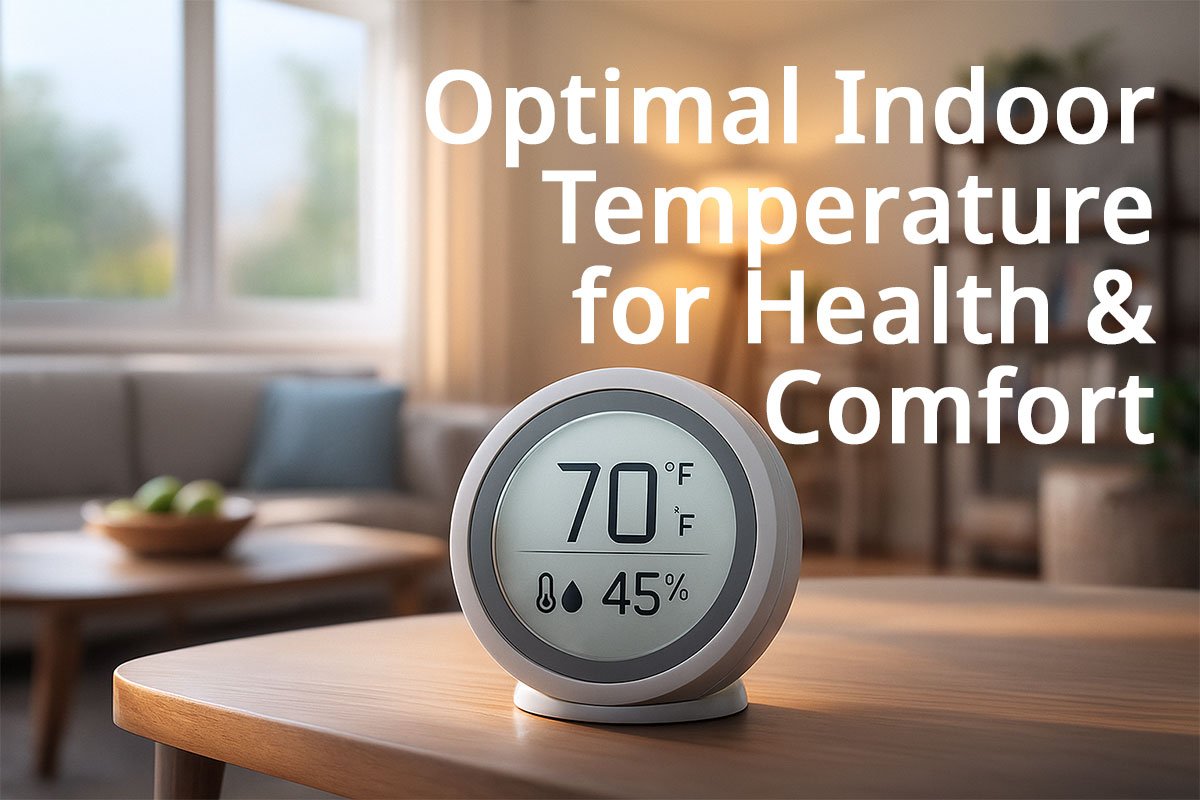What Science Says About the Best Home Temperature Range
Indoor temperature is far more than a matter of comfort or personal preference—it directly influences health, sleep quality, cognitive performance, respiratory wellness, energy usage, and even the long-term durability of building materials. Most people experience temperature changes in their homes daily without realizing how deeply these fluctuations affect the body and indoor environment. Numerous scientific organizations, including ASHRAE, the World Health Organization (WHO), the U.S. Department of Energy, and medical institutions such as Harvard Medical School, have studied how temperature affects human physiology. Their findings consistently point to a surprisingly narrow temperature window that supports both physical health and energy efficiency. Straying too far above or below this range can strain the body in subtle ways—from affecting hormone regulation to increasing respiratory irritation or worsening chronic conditions like asthma.
One of the key reasons indoor temperature matters so much is because the human body maintains a precise internal temperature of about 98.6°F (37°C). Even small changes in the surrounding environment influence how hard the body must work to stay within this narrow range. When indoor temperatures rise too high, the body compensates by increasing sweat production and heart rate, which can lead to dehydration and a reduction in cognitive performance. Conversely, when indoor temperatures fall too low, the body constricts blood vessels to preserve heat, which can increase blood pressure, aggravate breathing conditions, or make cold and flu viruses more likely to survive and spread. Scientific studies show that maintaining a stable indoor temperature reduces physiological stress and supports healthier breathing, deeper sleep, and improved mental focus.
Modern homes complicate temperature regulation because they are constructed with airtight building envelopes designed for energy efficiency. While this reduces energy costs, it also reduces natural ventilation and airflow. As a result, indoor temperature can shift rapidly due to cooking, running appliances, seasonal weather changes, or HVAC cycling patterns. Poor insulation, air leaks, or temperature stratification between floors can create microclimates within the same home—warm upstairs bedrooms, for example, and cold corners near exterior walls. These imbalances influence how comfortable a home feels even when the thermostat displays a seemingly ideal number. The solution requires not just adjusting the thermostat, but understanding the science of comfort and how temperature interacts with humidity, air movement, and personal physiology.
According to the scientific consensus, the ideal indoor temperature for most households falls between 68°F and 72°F (20°C–22°C) during the day when people are active. This range supports metabolism, reduces respiratory stress, and provides the highest comfort levels for the largest number of people. At night, cooler temperatures are preferable. Research shows that the body prepares for sleep by lowering its core temperature, so keeping the bedroom between 60°F and 67°F (15.5°C–19.5°C) supports melatonin production, reduces nighttime awakenings, and promotes deeper, more restorative sleep. These ranges represent the intersection of what experts consider healthy, efficient, and comfortable for long-term living.
The temperature ranges above may need adjustment depending on household composition, climate, or health conditions. For instance, infants, elderly adults, or individuals with compromised immune systems may require slightly warmer environments. People in humid or tropical regions may feel comfortable at cooler temperatures, while those living in dry climates may prefer slightly warmer indoor conditions. The key is understanding your home’s environmental context and recognizing the signs that your indoor temperature may be working against your health.
The lists below summarize the most scientifically supported temperature guidelines and the major factors affecting indoor comfort.
Recommended Indoor Temperatures for Daily Living
- 68–72°F (20–22°C) for daytime living and general household comfort
- 60–67°F (15.5–19.5°C) for nighttime sleep and optimal rest
- 65–70°F (18–21°C) when infants, elderly individuals, or sick household members are present
- 66–70°F (19–21°C) for working from home to support focus and reduce fatigue
- 70–74°F (21–23°C) for homes in very humid climates to offset humidity’s warming effect
Key Factors That Influence Optimal Indoor Temperature
- Humidity: Higher humidity makes the same temperature feel warmer; low humidity makes it feel cooler
- Insulation: Poorly insulated homes lose heat quickly, requiring higher settings for comfort
- Seasonal weather: Winter comfort levels differ from summer due to air dryness and temperature gradients
- Airflow patterns: Stagnant air can feel warmer or colder than air that circulates properly
- Physical activity: People who move frequently can tolerate cooler temperatures more easily
- Health conditions: Asthma, allergies, and circulation issues affect temperature sensitivity
- Home layout: Multi-story homes often have warmer upper levels due to rising air
Although these guidelines help most households, they only tell part of the story. Temperature interacts closely with humidity, air quality, and heat distribution. For example, a home at 70°F with 65% humidity will feel significantly warmer than a home at 70°F with 30% humidity. This is because humidity interferes with the body’s natural cooling mechanism—evaporating sweat. Conversely, a very dry home at 68°F can feel uncomfortably cold and lead to chapped skin, irritated sinuses, or static electricity buildup. Managing temperature therefore requires an understanding of how humidity affects perception. Most building-science experts recommend maintaining indoor humidity between 30% and 50%, with 40–45% being ideal for both comfort and respiratory health.
Another factor often overlooked is the role of indoor air movement. Small variations in airflow can cause drafts or create hot and cold pockets, making a home feel inconsistent in temperature even when the thermostat is properly set. Ceiling fans, strategically placed vents, and proper HVAC balancing can improve comfort dramatically without changing the thermostat setting. In winter, ceiling fans running at a low speed in reverse help push warm air down from the ceiling, while in summer, forward rotation helps create a cooling breeze. These adjustments improve temperature distribution, making the home feel more comfortable across all rooms.
Temperature also has a measurable impact on sleep quality, one of the most studied aspects of indoor temperature science. The human body follows a circadian rhythm that lowers core temperature in the evening. Cooler environments encourage this transition and signal the brain to release melatonin. Harvard Medical School and sleep-research institutions have demonstrated that rooms set between 60°F and 67°F significantly improve sleep depth, reduce nighttime sweating, and minimize the risk of sleep interruptions. Sleeping in rooms warmer than 75°F, on the other hand, can increase heart rate, reduce REM sleep time, and worsen sleep disorders such as insomnia or sleep apnea.
Beyond health and comfort, indoor temperature influences the home’s structural integrity and energy efficiency. Temperature changes affect the rate of expansion and contraction in building materials—especially wood, drywall, and flooring. Rapid temperature swings may cause cracking, warping, or joint separation. Consistent indoor temperature therefore extends the lifespan of building components and lowers long-term maintenance costs.
Energy consumption is another major factor. Heating and cooling systems account for approximately 40–50% of total household energy use, making temperature one of the strongest predictors of energy bills. The U.S. Department of Energy says homeowners can save up to 10% annually by adjusting the thermostat 7–10°F lower during winter sleeping hours or when the home is unoccupied. Smart thermostats boost savings by learning household schedules and adjusting temperatures automatically. These devices often incorporate occupancy sensors, humidity feedback, and adaptive algorithms that gradually reduce energy usage while maintaining comfort.
Indoor temperature also affects air quality. Dust mites, for example, thrive in warm, humid conditions. Keeping indoor temperatures moderate and humidity in check can reduce mite populations and minimize allergic reactions. Similarly, certain viruses survive longer on surfaces at cooler temperatures, which is why maintaining a healthy balance—not too hot and not too cold—is ideal for year-round wellness.
Ultimately, achieving the right indoor temperature is not about choosing a single number. It is about creating a holistic environment where temperature, humidity, ventilation, and building design work together to support comfort and health. A well-balanced home maintains stable, moderate temperatures, promotes steady airflow, controls humidity, and adapts to seasonal changes. Achieving this balance allows homeowners to enjoy cleaner air, deeper sleep, improved productivity, and lower energy costs—all while preserving the long-term integrity of the house itself.
Temperature will always fluctuate with daily life, but by understanding the science behind comfort and using the recommended ranges as a guide, homeowners can create indoor environments that feel good, function efficiently, and support long-term health.
Scientific Sources
- ASHRAE Standard 55 – Thermal Environmental Conditions for Human Occupancy
https://www.ashrae.org/technical-resources/bookstore/standard-55 - U.S. Department of Energy – Energy Saver Guide: Thermostat Settings
https://www.energy.gov/energysaver/thermostats - World Health Organization – Housing and Health Guidelines
https://www.who.int/publications/i/item/9789241550376 - Harvard Medical School – Sleep & Temperature Regulation Research
https://sleep.hms.harvard.edu/healthy-sleep/temperature-and-sleep - National Institute of Standards and Technology (NIST) – Indoor Comfort & Energy Studies
https://www.nist.gov/programs-projects/indoor-air-quality-and-thermal-comfort




